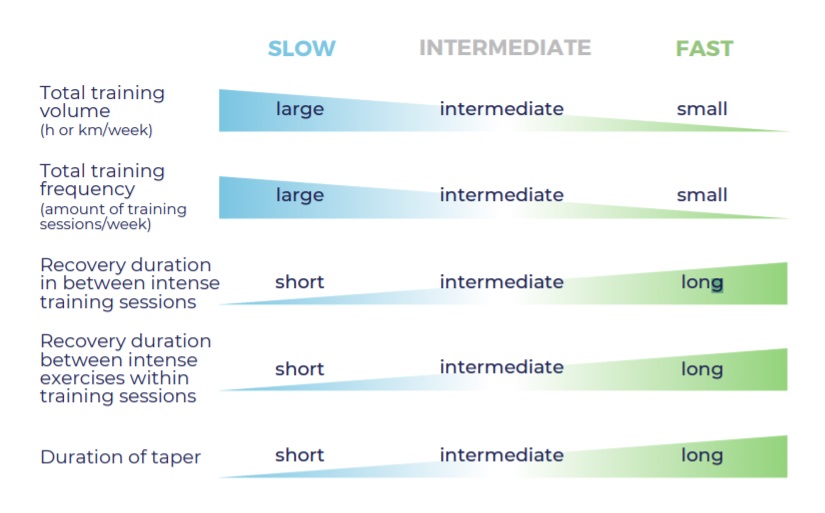Each one of us has both slow-twitch and fast-twitch muscle fibres, but the ratio between them is different for every individual. While you can’t do much to change the distribution of your own muscle fibre types, new research shows you can adapt your training to your specific muscle make-up to prevent injuries and maximize your performance.
Slow-twitch vs. fast-twitch
What is the muscle fiber typology?
Two different types of muscle fibers are responsible for production of movements:
👉slow-twitch 🔴 & fast-twitch fibers ⭕️
Both types are present in all muscles, but their proportion differs between individuals & determines the 'myotype'. pic.twitter.com/dsbMeOLBVq
— Eline Lievens (@eline_lievens) September 28, 2021
Study author Eline Lievens explains that both fast-twitch and slow-twitch fibres are present in all of your muscles, but the proportions of each differ from person to person. This distribution determines your myotype. Slow-twitch fibres are meant for slow, long-lasting exercise, while fast-twitch are for fast and powerful actions.
Lievens says that although humans evolved to have a slower myotype, there is a large spread in muscle fibre type between humans, from 20 per cent to 90 per cent slow-twitch fibres. This distribution has led researchers to classify humans into three myotype categories: slow, intermediate or fast (or, as she describes them, albatross, ape or cheetah).
What is your myotype: albatross, ape or cheetah?
The myotype follows a Gaussian distribution, indicating that most people are intermediate ⚪️ (like an ape🐒), but some are dominantly slow 🔵 (like an albatross🕊️) and others dominantly fast 🟢 (like a cheetah🐅). pic.twitter.com/xHacsQ3mVy
— Eline Lievens (@eline_lievens) September 28, 2021
Slow-twitch fibres, as their name suggests, are meant for slow, long-lasting exercise, while fast-twitch are for fast and powerful actions. Slow-twitch fibres are also much more energy-efficient and require three times less energy than fast-twitch fibres to produce the same contraction. They are also much more resistant to fatigue and injuries, which is why they are so important for endurance athletes.
Every muscle in your body will have a mixture of slow and fast-twitch fibres, but the distribution won’t be the same everywhere. For example, your soleus (one of the muscles that make up your calves) is predominantly slow-twitch, while your triceps are predominantly fast-twitch. If you have a slow (albatross) myotype, however, you will have more slow-twitch fibres in all of your muscles than the average population.
How does your myotype affect your training?
Can we adapt a training program based on the myotype?
💡Results from an overload study
16 high level runners🏃performed 3 weeks of overload training.
Runners with a faster myotype 🟢 showed a higher incidence of functional overreaching.
➡️ Fatigue accumulation was higher pic.twitter.com/1JS8MwxAcK— Eline Lievens (@eline_lievens) September 28, 2021
For endurance runners (which Lievens defines as anyone running longer than 1,500m), having more slow-twitch fibres will improve your running economy, which will allow you to run longer without fatiguing. Athletes with the slow myotype also recover faster, which means they can take less rest between intervals during a workout and can train with more frequency day-to-day and week-to-week.
Due to the lower energy efficiency of fast-twitch muscle fibres, athletes with a fast myotype are at a greater risk for over-training or over-reaching because they are more likely to accumulate fatigue over time without adequate rest between sessions. These athletes also require a longer taper period ahead of their goal race than slow-myotype athletes.

All of this suggests that you can adjust your training based on your myotype to maximize performance while reducing your risk for overtraining and injuries.
Are you an albatross, ape or cheetah?
Can the myotype be estimated in a non-invasive way?
✅Yes!
A method using an MRI-scan was invented in which calf muscles are scanned to determine the concentration of a fast-twitch metabolite, which is then translated into a myotype.👍 Applicable in athletes
👍 Low variation pic.twitter.com/XwMi90FZTm— Eline Lievens (@eline_lievens) September 28, 2021
Unfortunately, finding out your exact muscle fibre type distribution isn’t very easy. For many years, the only way to learn your myotype was to have a muscle biopsy, which is an invasive and painful procedure. Lievens and her colleagues have developed a new, non-invasive scan technique using MRI imaging to determine your myotype, however, there are only two facilities offering these scans in Belgium or The Netherlands.
Of course, most of us won’t be traveling to Europe to have a muscle scan, but by listening to your body you can apply these principles to your training. Do you tend to recover quickly between intervals and workouts? Or do you need a day off between sessions or more recovery time between intervals in order to produce the same effort? It may take some trial and error, but understanding how your body responds to different types, intensities and volumes of running can help you tailor your training to your body so that you perform at your best and stay injury-free.
Slow-twitch vs. fast-twitch muscle fibres: how your muscle type affects running performance - Canadian Running Magazine
Read More
No comments:
Post a Comment